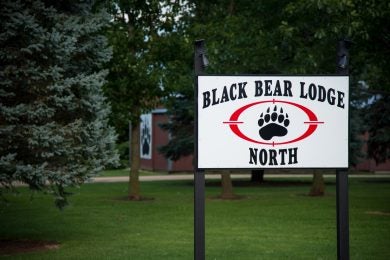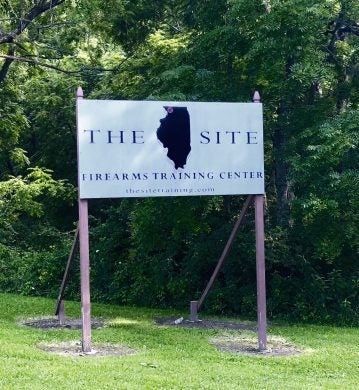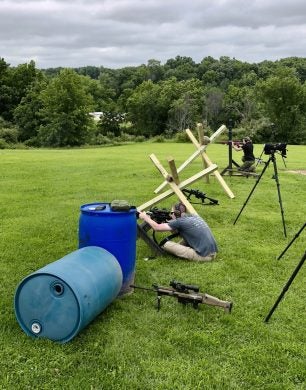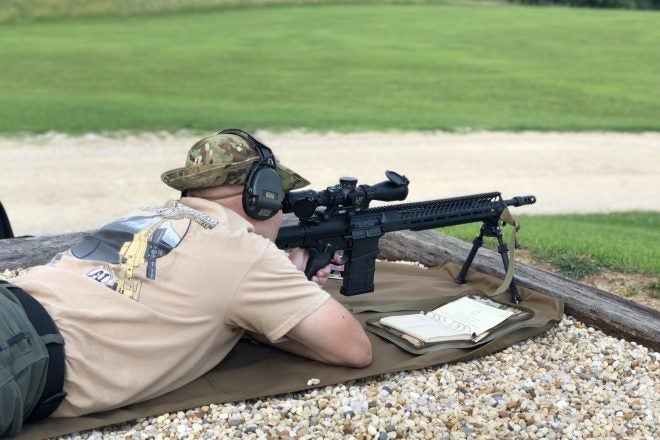Designated Marksman Rifle Course – After Action Report
A couple of cops I know said, “hey let’s take this DMR class together”. Bros, guns, and a mini-vacation sounded pretty great to me. To turn down the opportunity would have been foolish. I actually had no idea what a designated marksman was or what role they play in the military. I had a broad idea based on my law enforcement background, but I have never been in the military, and this course was being taught by a Navy SEAL. What follows is my after action report and a few tidbits I learned along the way while at Designated Marksman Rifle – The Site training facility.
 Day One: I arrived at Black Bear Lodge just north of Mount Carroll Illinois and was welcomed by the immaculately clean and well-kept property there. The staff clearly cares about making a good first impression on their guests. Black Bear Lodge is part of The Site Firearms Training Center. If you are attending a course at The Site, you have the option to sleep and eat at the lodge, and I highly recommend that you do! The price for a room in the lodge starts at just $50.00 a night, and $65.00 per night for a private cabin. These prices increase if you are staying in the space alone, so take a buddy or two and save some money.
Day One: I arrived at Black Bear Lodge just north of Mount Carroll Illinois and was welcomed by the immaculately clean and well-kept property there. The staff clearly cares about making a good first impression on their guests. Black Bear Lodge is part of The Site Firearms Training Center. If you are attending a course at The Site, you have the option to sleep and eat at the lodge, and I highly recommend that you do! The price for a room in the lodge starts at just $50.00 a night, and $65.00 per night for a private cabin. These prices increase if you are staying in the space alone, so take a buddy or two and save some money.
We stayed in the cabins you see here. The cabins are named after each branch of the armed forces. I chuckled at the apparent lack of a Coast Guard cabin. Ours was the “Marines” cabin. No crayons were found to my disappointment, but what I did get was a warm shower, comfortable bed, and a good night’s sleep.
The cabins are named after each branch of the armed forces. I chuckled at the apparent lack of a Coast Guard cabin. Ours was the “Marines” cabin. No crayons were found to my disappointment, but what I did get was a warm shower, comfortable bed, and a good night’s sleep.
For your information, The Site was once owned by Blackwater back in the day and was used for training law enforcement, military, and government contractors before being sent around the world to perform their security or “peacekeeping” functions. I tell you this to highlight that no expense was spared in the creation of this facility. It’s top-notch in so many ways. Here’s a list of what they offer.
- 1) Live-fire shoot house: 2700 square feet, multiple rooms with ballistic walls and ballistic bullet traps with an overhead catwalk for instructor evaluation
- 2) 50-yard general purpose range
- 3) Covered, air-conditioned/heated 45-yard general purpose range
- 4) Pistol caliber only steel: Five falling plate racks, dueling tree and Texas Star targets
- 5) 50-yard general purpose range with variable speed moving target system
- 6) Jungle walk: Live-fire tactical and hunting rifle courses with reactive steel targets
- 7) 100-yard general purpose range
- 8) 600-yard rifle range: Variable speed moving target system
- 9) Two story simulation house: Realty based non-lethal Simunitions type training. Lower floor: 2900 sq ft, Upper floor: 826 sqft
The Site’s President and Director of Training is former Navy SEAL Master Chief, Jim Kauber. After serving 20 years in the SEAL Teams, Jim continued post-9-11 employment in support of allied military and US Government national security-related assignments worldwide.In a training capacity, he held positions as the primary precision rifle instructor for the US Department of Energy’s Central Training Academy, Gunsite Academy, Blackwater North, O’Gara Group, Cheytac, Global Options, and The Site, in addition to training law enforcement snipers and European coalition Special Operations Forces’ snipers in support of OEF. Jim was recently the High-risk Training Safety Officer for Naval Special Warfare Command, Coronado, CA overseeing all SEAL and Special Warfare Combatant – Crewman, SWCC hazardous training programs.
As you can clearly see, Kauber is more than qualified to teach these courses. What isn’t stated here is the wealth of experiences he has had over the years that translates into wisdom and humility in his personality. From an instruction standpoint, Kauber delivers the course material with fluidity and ease. He’s an excellent communicator that understands his students need patience sometimes. In short, he is very easy to get along with and learn from.
 Day two: After breakfast, we made the short drive from the lodge to the range and mustered in the classroom. We would spend the first four hours of the day on introductions, covering theory, and a breakdown of what the weekend would hold for us. After the provided buffet style lunch, we met on the 100-yard line and prepped our gear and rifles for zeroing.
Day two: After breakfast, we made the short drive from the lodge to the range and mustered in the classroom. We would spend the first four hours of the day on introductions, covering theory, and a breakdown of what the weekend would hold for us. After the provided buffet style lunch, we met on the 100-yard line and prepped our gear and rifles for zeroing.
This is DMR, not precision rifle. You don’t need a perfect group on paper. Just hit the target!
I’m a precision rifle competitor so I obsess over tiny groups and best calibers with light recoil, so this “good enough” mentality was hard for me at first. I was shooting the Daniel Defense DD5V2 in .308 that they graciously provided to me for test and evaluation. It ran perfectly with no malfunctions. The ammunition I chose was the Fiocchi Exacta 168 grain match, and it produced three-quarters-of-a-minute groups at 100 yards. This easily fell inside Kauber’s “good enough” guidelines. Even when we moved to 200, 300, 400, and 500 yards, this ammunition kept delivering excellent results out of the DD5V2. I was impressed.
Kauber says he cringes everytime the DMR class comes up on his calendar because invariably students will show up with extremely low-quality rifles and optics. Instructors will then spend the entire first day fixing equipment instead of shooting. Thankfully our class didn’t have a single person with a subpar kit. Students used everything from custom AR15 builds to SCAR heavies to a Seekins SP10. The optics low end was the Sig Tango 4 which is a great scope. The high end was a Nightforce ATACR. I used the Vortex Razor Gen2 3-18x on top of the DD5V2 and it turned out to be the perfect compliment for this fine rifle and the DMR distances we were shooting at. Day one concluded with an excellent steak dinner and some much needed sleep.
 Day Two: Breakfast, muster, safety briefing, then immediately out to the 600 yard-line for drop data confirmation and wind estimation practice. If you’ve never shot past 300 yards then you wouldn’t know that wind is the most difficult part of long-range shooting. It’s really the only variable you can’t control, and it literally changes every few seconds. Learning to read the wind based on vegetation, mirage, and previous shots are mandatory if you want success. We spent several hours just learning to watch the wind and understand its effects on our bullets. This was extremely beneficial for me even though I’ve been shooting long range for years.
Day Two: Breakfast, muster, safety briefing, then immediately out to the 600 yard-line for drop data confirmation and wind estimation practice. If you’ve never shot past 300 yards then you wouldn’t know that wind is the most difficult part of long-range shooting. It’s really the only variable you can’t control, and it literally changes every few seconds. Learning to read the wind based on vegetation, mirage, and previous shots are mandatory if you want success. We spent several hours just learning to watch the wind and understand its effects on our bullets. This was extremely beneficial for me even though I’ve been shooting long range for years.
Next, we moved on to barricade work. Kauber wanted to get us off our belly and out of the prone position. The DMR role is very seldom a static position. It’s constantly changing and you never know what types of cover or other structure will be available to shoot from. Building a solid shooting position in a hurry was the focus of this training evolution. We shot off of 55-gallon drums, tank traps, barricades that resembled window ledges, and tripods just to name a few.
Just before another stellar meal at the lodge, we shot a stress drill that had us working in shooter/spotter pairs to engage randomly selected targets at varying distances under time constraints. This portion of the class resembled a Precision Rifle Series style match that I have become very accustomed to. It was great training and a ton of fun!
After lunch, and for the remainder of the day to conclude the course, we would learn how to shoot moving targets from a distance of 500 yards. This began in the classroom of course because there are some theory and math involved as you might imagine. Learning to shoot movers is straightforward once you understand your bullet’s time of flight and how fast your target is moving. You just plug those numbers into an equation and you have the basics of what you need to make the shot, that is if the shot was in a vacuum with no influence from weather conditions and wind.
Understanding how the wind would affect the shot on a moving target was less intuitive. Jim Kauber has what he calls “Kauberisms”. These are easily rememberable sayings that help people recall complex material in “brainstem simple” terms. For moving targets and wind, the Kauberism was “keep your I’s and D’s straight”. The “I” is for increase, and yep you guessed it, the “D” is for decrease. If a target is moving into the wind you need to increase your lead in order to get a hit, and if a target is moving downwind you need to decrease your lead in order to impact the target. As I said, Jim Kauber is a wealth of knowledge and this barely cracks the surface of what the man knows. I was thankful he understood guys like me need it simple.

Jim Kauber – middle
In summary, I had an excellent time at The Site Firearms Training Center. The designated marksman rifle class was safe, well organized, and professionally taught. The range facilities were top notch and impeccably clean. The lodge, where I stayed on site, and where we ate all our meals, was clean and well cared for. A large room full of recliners and a big screen t.v. were welcome comforts at the end of each day. If you prefer a glass of whiskey or a beer around the campfire, that was available too. I came away from the class with a better understanding of what it takes to make hurried hits on targets at varying distances, from unorthodox positions, with a large frame AR type weapon system. In my opinion, this class is an excellent value. You can find more information about The Site by visiting their website.
 Your Privacy Choices
Your Privacy Choices
